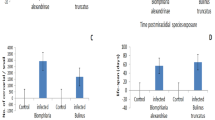Abstract
Snail hosts of different ages constitute different resource environments for larval trematodes because each individual has a particular energy budget and energy allocation pattern at the time of infection. Effects of monomiracidial trematode infections on shell growth, body dry weight and reproductive effort of the snail host were compared between controls and infected juvenile and adult snails during the prepatent and patent periods. The results demonstrate phenotypic plasticity in the host response. There is an age/size-specific effect characterized by limitation of growth rate when snails are infected as juveniles and reduction of reproductive effort when snails are infected as adults, and a time-specific effect with early enhancement of growth rate and reproductive effort for infected juvenile and adult snails respectively during prepatency, before reduction and cessation during patency. The parasite is considered as a generalist in its energy exploitation strategy of the snail host, but taking into account the differential host responses observed relative to the host age, the possibility of a host preference for juvenile or adult snails is discussed.
Similar content being viewed by others
Author information
Authors and Affiliations
Additional information
Received: 4 February 1997 / Accepted: 14 July 1997
Rights and permissions
About this article
Cite this article
Gérard, C., Théron, A. Age/size- and time-specific effects of Schistosoma mansoni on energy allocation patterns of its snail host Biomphalaria glabrata . Oecologia 112, 447–452 (1997). https://doi.org/10.1007/s004420050331
Issue Date:
DOI: https://doi.org/10.1007/s004420050331




